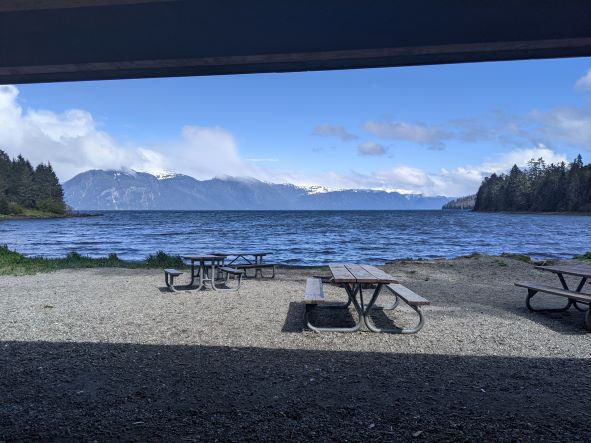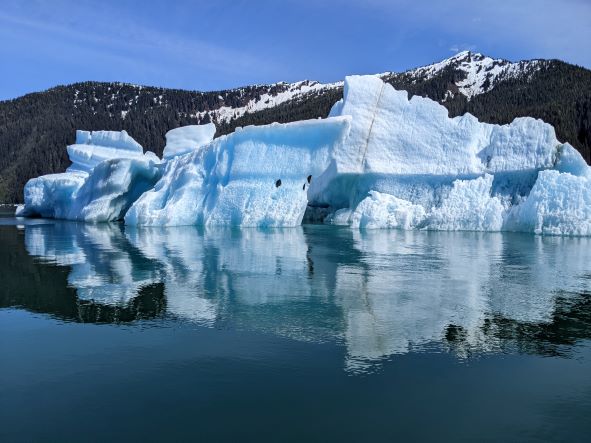I can’t believe it’s already June! The second year of my fellowship is really flying by. The highlights of the past few months have definitely been the opportunities to interact with my colleagues in person. In April, Oregon Sea Grant held a two-day program meeting in Newport and I really enjoyed “meeting” everyone who I’d previously only seen in a tiny square on my computer screen. In May, I had the amazing opportunity to spend a week in Petersburg, Alaska for a workshop with West Coast Sea Grant Programs on connecting fisheries and aquaculture across the region. The workshop brought together folks from Oregon, Washington, Alaska, and California Sea Grant programs to share our work on aquaculture and fisheries. We participated in training, went on field trips, and worked on collaborative regional projects.
First of all, let me tell you about the small fishing town of Petersburg which sits at the tip of an island. The five hour flight to get there makes two stops on the way, and the airport building is about the size of a gas station. The population is about 3,000 people, and almost everything is within walking distance. The town features Scandinavian architecture and on our last day there, they were starting the annual Little Norway Festival which celebrates Norwegian Constitution Day and brings in about 1000 visitors every year. The harbor boasts hundreds of fishing boats and Petersburg is known for its diverse fishing industry that includes salmon, halibut, blackcod, herring, crab, shrimp, clams, and more!
On Monday, the first day of the workshop, we met at a local beach park to get to know each other and share updates on our work. While we were there the tide at the beach continued to recede and show a dramatic change, which was really cool to watch. The pictures below show the change within just a few hours.


The next day we spent the morning in training about “Best Practices for Adult Education.” All of us attending the workshop conduct outreach and engagement with primarily adult audiences in fishing and aquaculture communities so this was really useful. After spending the morning on Zoom, we headed outside to tour a local fish hatchery that raises juvenile Salmon to support recreational and commercial fisheries. We were lucky enough to be there when they were releasing juveniles into the adjacent river through a large tube that transported the fish from holding tanks into the water. The picture below shows the fish emerging from a tube into the river in a swarm.

Next we went on to tour river restoration sites with a researcher from the U.S. Forest Service. These sites have been restored in recent years to provide better and more diverse habitat for salmonids that live and/or spawn in freshwater. There are some pictures of the restored site below.


On Wednesday, we spent the day indoors and listened to presentations over Zoom, worked on projects, and interacted with folks from the local fishing community. The highlight of this day for me was a panel on “Advocacy and the Role of Extension Agents.” At Sea Grant, extension agents work on a lot of controversial issues in coastal communities, but our role is to remain neutral and serve as facilitators of information and exchange. In practice, this is really challenging, especially when residing in small coastal towns where everyone knows each other. It can be difficult to separate your personal and professional affiliations. While my fellowship has been remote and I haven’t experienced living in a small coastal community, I have had challenges with determining an appropriate role to not advocate for aquaculture, but instead provide information from a neutral place. This panel made me feel less like an imposter, as others have similar struggles, and provided some practical advice for how to navigate these situations.
On Thursday, we gathered for a half day to wrap up, and then some of us went on an optional boat tour to the LeConte Glacier. This was absolutely the highlight of the trip. We spent about 5 hours on the boat with a local tour guide and coincidentally, a whale biologist. The wildlife on this tour was incredible! We saw humpback whales, porpoises, seals, sea lions, bald eagles, mountain goats, and a black bear. Traveling on the boat to the glacier through sea ice was an experience I will never forget. While we didn’t get very close to the glacier, we did get quite close to two-story icebergs, including one that had recently flipped over. According to our guide, icebergs will rotate, and the ice underneath will be more blue and vibrant, while the ice above the water will be white and look more like snow. Once the iceberg rotates, the blueish ice will change to the whiter, snow-like ice within a few hours. We were lucky enough to see a flipped glacier on our way back from the glacier.



Overall, this trip was an incredible experience and I’m really grateful that Sea Grant provided the resources for me to get there!


Great post, Amy!! Sounds like the workshop in Petersburg was amazing and expanded your horizons and multiple levels. Thank you for sharing. Have you been able to use any of the new tools or techniques you learned about? Or do you anticipate that this workshop will enhance your work as a fellow or beyond? Sounds like you got some great tips on facilitation!
Wow, what a great summary. Thank you for drafting. Sounds like the workshop was informative on many levels and helped create connections within the SG fisheries and aquaculture community.